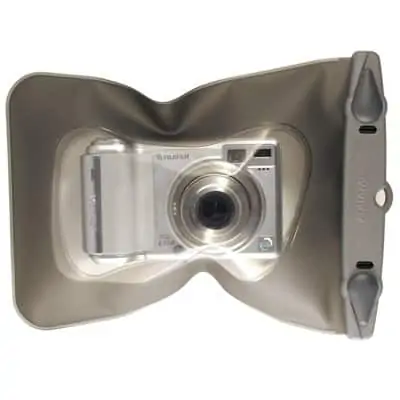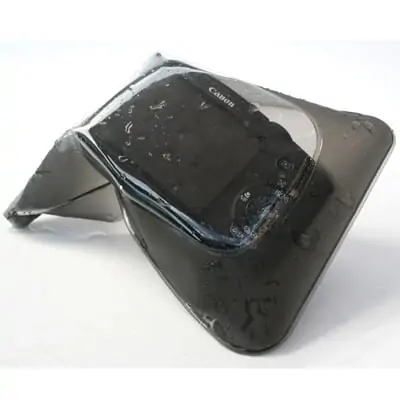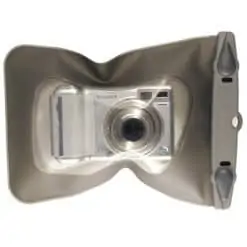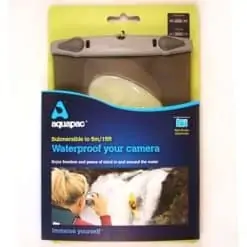Aquapac Waterproof Camera Case Small
£24.95
2 in stock
For small compact cameras with some zoom use.
Use your camera safely at the beach, on the boat, or in the pool.
Even underwater!
What’s so special about this case?
- It allows you to get photos when it’s really wet. And yes, even underwater!
- It’s sand-proof as well as waterproof so you can take your camera safely to the beach (Sand destroys even more cameras than water)
- It comes supplied with 3 desiccant sachets to absorb condensation in humid climates.
What else do I need to know?
- Your camera should float in this case – but make sure you test yours in a basin before you launch it into the sea!
- There’s enough room for some zoom use, but not much.
- You might want to consider the Mini with Hard Lens which is a premium alternative.
Is this the right size for my camera?
- This case was designed for small compact cameras.
- 265mm/10.2″
How Waterproof is it?
- IPX8
- Submersible – protected against continuous immersion to a depth of 30ft/10m
Colour
Cool grey with acid green lanyard
Materials
TPU with optically-clear LENZFLEX lens window
Weight
Case: 1.7oz / 49g Lanyard: 0.2oz / 7g
Country of Origin
Made in the UK
What else do I need to know?
- This case is 100% PVC-free. It is made of a special TPU which is thin enough for you to operate your camera through, but still remarkably strong.
- The seams are high-frequency welded to form a super-strong bond.
- The Aquaclip® seal opens and closes with a quick twist of two levers. And everything stays in one piece even when it’s open.
- Aquapac patented the Aquaclip system back in the 1990s. They have sold over 5 million Aquapacs, the vast majority of which are sealed with an Aquaclip. So you can have confidence that the waterproofness of our system is well-proven!
- Caution: It’s not foolproof. If you’re not careful you could get a hole in the case, or let water in when opening it. But as long as you treat it sensibly and carefully it should give you many years of use.
- It’s supplied with 3 desiccant sachets to absorb condensation in humid climates but we recommend you order extras.
Care Instructions
Warning
Aquapac’s warranty covers this Aquapac only, and not any items you may put inside it. They recommend that you insure the contents separately.
Waterproofness
Aquapac’s range has been independently tested to international waterproofing standards. However, the waterproofness of your Aquapac depends on your closing and opening it carefully, and on it not being damaged either before or during use. Please follow all instructions carefully.
Before Every Use
Seal something worthless inside, then submerge in a basin to check the waterproofness.
Closing the Case
Make sure that all parts are properly attached. Wipe away any grit or sand, which could hamper the seal. Always turn the levers as far as they will go. They should lock smoothly, if not there may be something impeding the seal.
Opening the Case
Never open your Aquapac in or under water. In order to stop any water getting in when you are opening it, first shake off any water then dry with a towel. Hold the case with the opening at the bottom as you open it.
Ongoing Care
Our materials are strong but can still be punctured. Avoid sharp or abrasive objects and protect from impacts. After regular contact with chlorinated or salt water, or with sun creams, wash in soapy water and then rinse with fresh water. Do not use bleach, alcohol or proprietary cleaners.
Materials
Aquapacs are made from a variety of materials, mostly plastics which make them rustproof. These include TPU, ABS, nylon and polypropylene.
Extreme Temperatures
Although the case material has been UV-stabilized – which means that the plastic shouldn’t be discoloured or broken down by sunlight – the Aquapac won’t protect anything inside it from heat or sunlight. The soft case material is functional and flexible in air temperatures -40ºC to +60ºC (-40ºF to +140ºF), and water temperatures up to +40ºC (+100ºF).
Humidity and Condensation
In humid climates there will be moisture in the air sealed inside the case. Desiccant sachets will absorb the moisture, keeping the contents completely dry. Aquapac recommend use of desiccant sachets in all Aquapacs in humid climates.
Warning
This is not a toy. It may contain small parts which may be a choking hazard to children under 3. Keep small parts away from children.
Tips for Taking Good Photographs
If you follow a few guidelines there’s no reason why anyone should notice that your photos were taken through a case. It’s a bit like taking a photograph through your window at home. First of all the window needs to be as clean as possible. Even with a clean window you may notice some reflection, but the closer you hold the camera lens to the window, the less the reflection. Similarly our cases give best results with the lens window tight against the camera lens. Try to avoid flash photography but if you do need to use the flash, make sure that the case is tight over the flash so the light doesn’t reflect back into the lens.
Underwater Photography
It takes a bit of practice – and a little luck – to get really good underwater photos. Please don’t think that every shot you take is going to make the cover of SportDiver magazine! You need strong sunshine and clear water. The middle of the day is best, when the sun’s at its highest. Best results will be just below the surface. Light disappears quickly as you go deeper, as do colours (one of the advantages of digital cameras is that you can retouch your photos afterwards to replace colours lost underwater). Flash rarely works underwater. Not because of the Aquapac, but because the flash tends to reflect off particles in the water itself. Even clean water is full of micro-organisms and other particles. The less water between you and your subject, the less difference this will make and therefore the clearer your shots are likely to be. Wide lens and close up is the secret.






